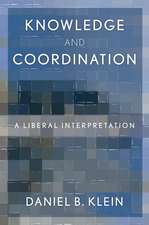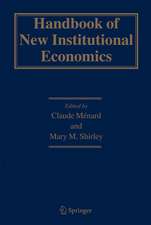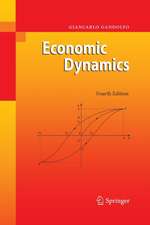Information and Classification: Concepts, Methods and Applications Proceedings of the 16th Annual Conference of the “Gesellschaft für Klassifikation e.V.” University of Dortmund, April 1–3, 1992: Studies in Classification, Data Analysis, and Knowledge Organization
Editat de Otto Opitz, Berthold Lausen, Rüdiger Klaren Limba Engleză Paperback – 5 iul 1993
Din seria Studies in Classification, Data Analysis, and Knowledge Organization
- 20%
 Preț: 754.09 lei
Preț: 754.09 lei - 20%
 Preț: 1203.30 lei
Preț: 1203.30 lei -
 Preț: 389.49 lei
Preț: 389.49 lei - 20%
 Preț: 587.28 lei
Preț: 587.28 lei - 18%
 Preț: 886.26 lei
Preț: 886.26 lei - 15%
 Preț: 654.43 lei
Preț: 654.43 lei - 18%
 Preț: 973.69 lei
Preț: 973.69 lei - 18%
 Preț: 1017.26 lei
Preț: 1017.26 lei -
 Preț: 417.41 lei
Preț: 417.41 lei - 18%
 Preț: 1113.09 lei
Preț: 1113.09 lei - 15%
 Preț: 645.14 lei
Preț: 645.14 lei - 15%
 Preț: 660.04 lei
Preț: 660.04 lei - 20%
 Preț: 583.37 lei
Preț: 583.37 lei - 15%
 Preț: 637.59 lei
Preț: 637.59 lei - 20%
 Preț: 997.38 lei
Preț: 997.38 lei - 18%
 Preț: 958.07 lei
Preț: 958.07 lei - 18%
 Preț: 954.45 lei
Preț: 954.45 lei - 18%
 Preț: 784.13 lei
Preț: 784.13 lei - 20%
 Preț: 999.53 lei
Preț: 999.53 lei - 18%
 Preț: 1391.52 lei
Preț: 1391.52 lei - 15%
 Preț: 657.25 lei
Preț: 657.25 lei - 18%
 Preț: 964.10 lei
Preț: 964.10 lei - 18%
 Preț: 962.35 lei
Preț: 962.35 lei - 15%
 Preț: 649.71 lei
Preț: 649.71 lei - 20%
 Preț: 1013.06 lei
Preț: 1013.06 lei - 15%
 Preț: 652.81 lei
Preț: 652.81 lei - 15%
 Preț: 647.73 lei
Preț: 647.73 lei - 20%
 Preț: 585.29 lei
Preț: 585.29 lei - 24%
 Preț: 795.77 lei
Preț: 795.77 lei - 20%
 Preț: 1464.66 lei
Preț: 1464.66 lei - 20%
 Preț: 559.43 lei
Preț: 559.43 lei - 15%
 Preț: 647.59 lei
Preț: 647.59 lei - 15%
 Preț: 650.04 lei
Preț: 650.04 lei - 15%
 Preț: 647.73 lei
Preț: 647.73 lei -
 Preț: 398.15 lei
Preț: 398.15 lei - 20%
 Preț: 572.08 lei
Preț: 572.08 lei - 15%
 Preț: 639.59 lei
Preț: 639.59 lei - 15%
 Preț: 683.40 lei
Preț: 683.40 lei - 15%
 Preț: 695.01 lei
Preț: 695.01 lei -
 Preț: 423.34 lei
Preț: 423.34 lei - 18%
 Preț: 945.30 lei
Preț: 945.30 lei - 15%
 Preț: 652.64 lei
Preț: 652.64 lei -
 Preț: 391.40 lei
Preț: 391.40 lei - 20%
 Preț: 561.11 lei
Preț: 561.11 lei - 20%
 Preț: 1002.67 lei
Preț: 1002.67 lei - 15%
 Preț: 640.37 lei
Preț: 640.37 lei - 20%
 Preț: 996.88 lei
Preț: 996.88 lei - 20%
 Preț: 1007.46 lei
Preț: 1007.46 lei - 15%
 Preț: 646.11 lei
Preț: 646.11 lei
Preț: 406.05 lei
Nou
Puncte Express: 609
Preț estimativ în valută:
77.70€ • 81.33$ • 64.67£
77.70€ • 81.33$ • 64.67£
Carte tipărită la comandă
Livrare economică 31 martie-14 aprilie
Preluare comenzi: 021 569.72.76
Specificații
ISBN-13: 9783540567363
ISBN-10: 3540567364
Pagini: 532
Ilustrații: XI, 517 p.
Greutate: 0.84 kg
Ediția:Softcover reprint of the original 1st ed. 1993
Editura: Springer Berlin, Heidelberg
Colecția Springer
Seria Studies in Classification, Data Analysis, and Knowledge Organization
Locul publicării:Berlin, Heidelberg, Germany
ISBN-10: 3540567364
Pagini: 532
Ilustrații: XI, 517 p.
Greutate: 0.84 kg
Ediția:Softcover reprint of the original 1st ed. 1993
Editura: Springer Berlin, Heidelberg
Colecția Springer
Seria Studies in Classification, Data Analysis, and Knowledge Organization
Locul publicării:Berlin, Heidelberg, Germany
Public țintă
ResearchCuprins
I: Data Analysis and Classification.- Classification Methods.- Hierarchical Clustering of Sampled Functions.- Spatial Clustering of Species Based on Quadrat Sampling.- A kn-Nearest Neighbour Algorithm for Unimodal Clusters.- Asymptotic Robustness in Cluster-Analysis for the Case of Tukey-Huber Distortions.- Choosing the Number of Component Clusters in the Mixture-Model Using a New Informational Complexity Criterion of the Inverse-Fisher Information Matrix.- Fuzzy Classification.- Fuzzy Sets and Fuzzy Partitions.- Fuzzy Clustering by Minimizing the Total Hypervolume.- Conceptual Analysis.- Conceptual Data Systems.- Conceptual Clustering via Convex-Ordinal Structures.- Diagrams of Similarity Lattices.- Approximate Galois Lattices of Formal Concepts.- Representation of Data by Pseudoline Arrangements.- Mathematical Characterizations.- A Relational Approach to Split Decomposition.- Some New Useful Representations of Dissimilarities in Mathematical Classification.- Multidimensional Scaling.- A Comparison of Two Methods for Global Optimization in Multidimensional Scaling.- Directional Analysis of Three-Way Skew-Symmetric Matrices.- Clustering in Low-Dimensional Space.- The Construction of Neighbour-Regions in Two Dimensions for Prediction with Multi-Level Categorical Variables.- Different Geometric Approaches to Correspondence Analysis of Multivariate Data.- Nonlinear Biplots for Nonlinear Mappings.- Various Methods for Data Analysis.- Gradient Filtering Projections for Recovering Structures in Multivariate Data.- Classification with Set-Valued Decision Functions.- Canonical Discriminant Analysis: Comparison of Resampling Methods and Convex-Hull Approximation.- Nonparametric Prediction of Time Series on the Basis of Typical Course Patterns.- Moving Point Patterns: The PoissonCase.- II: Information Retrieval, Knowledge Processing and Software.- Information Retrieval.- Representations, Models and Abstractions in Probabilistic Information Retrieval.- Fuzzy Graphs as a Basic Tool for Agglomerative Clustering and Information Retrieval.- The Various Roles of Information Structures.- Neural Networks.- Classification Properties of Communicating Neural Networks.- Knowledge Extraction from Self-Organizing Neural Networks.- Self-Organizing Neural Networks for Visualisation and Classification.- Expert Systems and Knowledge Processing.- HyDi: Integration of Hypermedia and Expert System Technology for Technical Diagnosis.- Classification and Learning of Similarity Measures.- Context Sensitive Knowledge Processing.- An Efficient Application of a Rule-Based System.- Computational Linguistics.- Acquisition of Syntactical Knowledge from Text.- Generating Topic-Based Links in a Hypertext-System for News.- Software.- Interactively Displaying Ultrametric and Additive Trees.- Anaglyphen 3D — A Program for the Interactive Representation of Three-Dimensional Perspective Plots of Statistical Data.- III: Applications and Special Topics.- Sequence Data and Tree Reconstruction.- Discovering Consensus Molecular Sequences.- Alignment and Hierarchical Clustering Method for Strings.- More Reliable Phylogenies by Properly Weighted Nucleotide Substitutions.- Caminalcules and Didaktozoa: Imaginary Organisms as Test-Examples for Systematics.- Data Analysis and Informatics in Medicine.- Multivariate Analysis of the Process of Acclimation of Physiologic Variables.- Classification of EEG Signals into General Stages of Anesthesia in Real-Time Using Autoregressive Models.- Automatic Segmentation and Classification of Multiparametric Image Data in Medicine.- Pseudoroots asDescriptors for a Thesaurus Based on Weidtman’s Diagnosis Table of Pediatrics.- Special Topics - Thesauri, Archaeology, Musical Science and Psychometrics.- An Approach to a Space Related Thesaurus.- Classification of Archaeological Sands by Particle Size Analysis.- The Analysis of Stratigraphic Data with Particular Reference to Zonation Problems.- Classification Criterion and the Universals in the Organization of a Musical Text.- A Two-Mode Clustering Study of Situations and Their Features.










